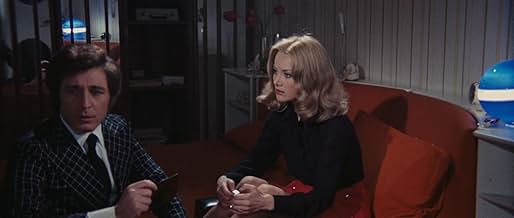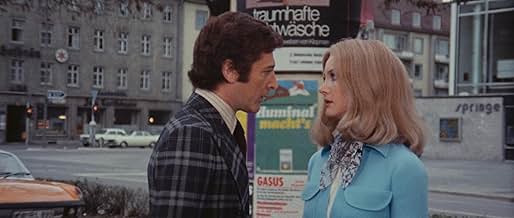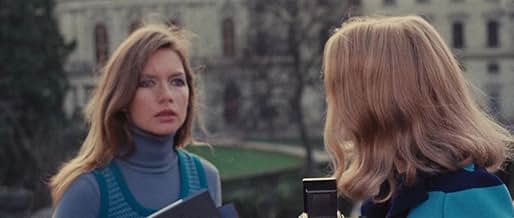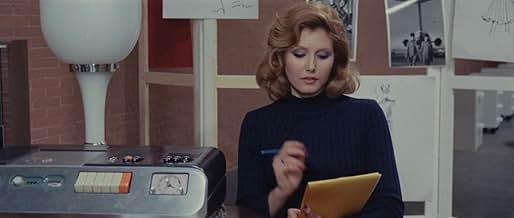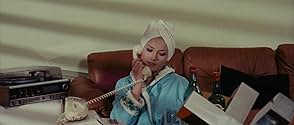Agrega una trama en tu idiomaTwo sisters inherit their family castle, which is said to be haunted by their ancestor: a raven-haired, red-robed woman who is said to commit seven murders every hundred years.Two sisters inherit their family castle, which is said to be haunted by their ancestor: a raven-haired, red-robed woman who is said to commit seven murders every hundred years.Two sisters inherit their family castle, which is said to be haunted by their ancestor: a raven-haired, red-robed woman who is said to commit seven murders every hundred years.
- Dirección
- Guionistas
- Elenco
- Rosemary Müller
- (as Maria Pia Giancaro)
- Tobias Wildenbrück
- (as Rudolf Schindler)
- Policeman
- (sin créditos)
- Leonora Roiburg
- (sin créditos)
- Policeman
- (sin créditos)
- Springe Management Member
- (sin créditos)
- Plainclothes Police Agent
- (sin créditos)
- Springe's Department Director
- (sin créditos)
Opiniones destacadas
Directed by Emilio P. Miraglia who, one year earlier, also made the very interesting "La Notte che Evelyn Usci della Tomba" (see also my comment on that one), the film starts off a little slow, but all in all, no time is wasted with unnecessary sub plots or sequences.
This film is a German-Italian coproduction, but it was released in Germany on video only in a version trimmed by 15 minutes of plot under the stupid title "Horror House". At least the murder scenes, which will satisfy every gorehound, are fully intact, and the viewer still gets the killer's motive at the end. But the Italian version containing all the footage is still the one to look for, of course.
A convincing Giallo with obligatory twists and red herrings, "La Dama Rossa Uccide Sette Volte" is highly recommended to Giallo fans and slightly superior to Miraglia's above mentioned other thriller.
Miraglia is good at storytelling as well as cinematic flair, giving us an engrossing mystery that offers up enough red herrings to keep things interesting. But, just like any good giallo, it delivers plenty of eye candy - of both the cinematic kind and the human female kind - to add to the presentation and make it quite watchable, even if anybody watching figures things out ahead of time. It just barely sort of flirts with the supernatural, with little surreal touches here and there, and is largely grounded in reality...albeit a stylized, sexualized reality. It can also boast a typically lovely Bruno Nicolai soundtrack; casual viewers may not recognize his name, but he deserves to be as well known as Ennio Morricone, one of the major legends of film music (Italian and otherwise).
The acting is good from the cast; there are some very handsome men and some positively gorgeous women among them. Bouchet is an engaging lead, and Ugo Pagliai is her likeable leading man. Marino Mase is excellent as the dedicated police inspector - what giallo would be complete without this sort of stock character? Rudolf Schundler is a delight as the concerned grandfather who gives us some back story, and B movie goddess Sybil Danning can be seen (clothed and unclothed) as a saucy character named Lulu Palm.
The kills are sure to satisfy gore lovers, and if you're an admirer of this genre, you'll be intrigued by the way that Miraglia switches between a traditional Gothic setting (the family castle) and the modern urban environment. One highlight is when a victim is dragged to their death by a car after their jacket gets caught in the car door.
The sixth, and sadly final, directorial outing for Miraglia, who'd been a script supervisor and assistant director for many years; previously he'd done another giallo, the equally lauded "The Night Evelyn Came Out of the Grave".
Seven out of 10.
The whole movie is a bit of a jumble of plot and events, as people close to or somehow linked to Kitty start to die horribly. The movie does look good, thanks to the lovely actresses who appear in it, and there are some great shots of the "Red Queen" killer (in a long red cape, black hair and white face) dashing about the place. There's also a fairly spectacular castle setting with suitable creepy rooms and dungeons. The explanation is almost impossible to piece together, but at least it's something you couldn't really figure out!
The prologue is also important as it shows how Kitty (as a child) first learned about the legend, and we get to hear the improbable story, as well as see a ridiculously gory painting which the family have deemed suitable to be hung in full view on a wall! Sadly, what doesn't work is the English dub, which is dreadful and it especially hampers this prologue, because the only thing worse than bad dubbing is bad dubbing of children, and here it's excruciating. There is a fair bit of gore, but the blood looks like tomato soup and there are no really good effects to be seen. However it's all energetic and well paced, and there is a lot of topless female nudity to keep the male audience members entertained. Worth a look.
Now, the Wildenbruck family -some of whom have dark secrets to hide- has gathered for the reading of their patriarch's will. Very quickly, people are stalked and killed by a laughing, red-cloaked maniac. Has the Red Queen returned once more to seek her vengeance? As the murders continue, Kitty Wildenbruck (Barbara Bouchet) grows increasingly concerned, and for good reason.
TRQK7x is a masterful giallo with a lot of gothic horror overtones. Co-stars the magnificent Sybil Danning as Lulu Palm...
Later on, their grandfather tells them the legend related to the picture hanging on the wall in front of them, in which a lady dressed in black is stabbing a lady dressed in red:
"A long time ago, a red lady and a black lady lived in the same castle. They were sisters and hated each other. One night, for jealousy reasons, the black lady entered the red lady's room and stabbed her seven times. One year later, the red lady left her grave. She killed six innocent people, and her seventh victim was the black lady. Once every hundred years, the events repeat themselves in this castle and a red lady kills six innocent victims before killing the black lady herself."
The grandfather ends his tale by saying that according to the legend, sixteen years from now, the red queen should come again and kill seven times. But he assures them that this is just an old legend.
Sixteen years pass.....
This is the very beginning of the film. There are many twists and surprises in the film. It's better for you to forget about logic (if you really analyse it, the story doesn't make sense) and just follow the film with its wonderful colors, the gorgeous women, the clothes, the tasteful decor, the lighting effects and the beautiful soundtrack.
Enjoy Barbara Bouchet, Sybil Danning, Marina Malfatti, Pia Giancaro, among other goddesses. There's a nude by Sybil Danning lying on a sofa that's something to dream about. And don't forget: The lady in red kills seven times!
If you've liked "La Dama Rossa..." check out also "La Notte che Evelyn uscì dalla Tomba".
¿Sabías que…?
- TriviaThough the film was co-produced by a West German production company and mostly shot in West Germany, it was never released theatrically there. Instead, it premiered straight to home video in the late 1980s.
- ErroresWhen Kitty knocks Eveline against the stone base of the obelisk, presumably knocking her out, no blood is shed. Cut to the body in the water, and it is instantly surrounded by a ring of blood.
- Citas
Martin Hoffmann: I already have enough women.
Lulu Palm: Sure, a wife in a psychiatric hospital, and that other one, Kitty. I bet when you go to bed, you don't make love, you just talk about it.
Martin Hoffmann: And if I like to talk about love?
- Versiones alternativasAmerican release was cut in the violence to ensure a "PG" rating.
- ConexionesFeatured in Año nuevo satánico (1980)
Selecciones populares
- How long is The Red Queen Kills Seven Times?Con tecnología de Alexa
Detalles
- Fecha de lanzamiento
- Países de origen
- Idioma
- También se conoce como
- The Red Queen Kills Seven Times
- Locaciones de filmación
- Productoras
- Ver más créditos de la compañía en IMDbPro
- Tiempo de ejecución
- 1h 39min(99 min)
- Mezcla de sonido
- Relación de aspecto
- 2.35 : 1


